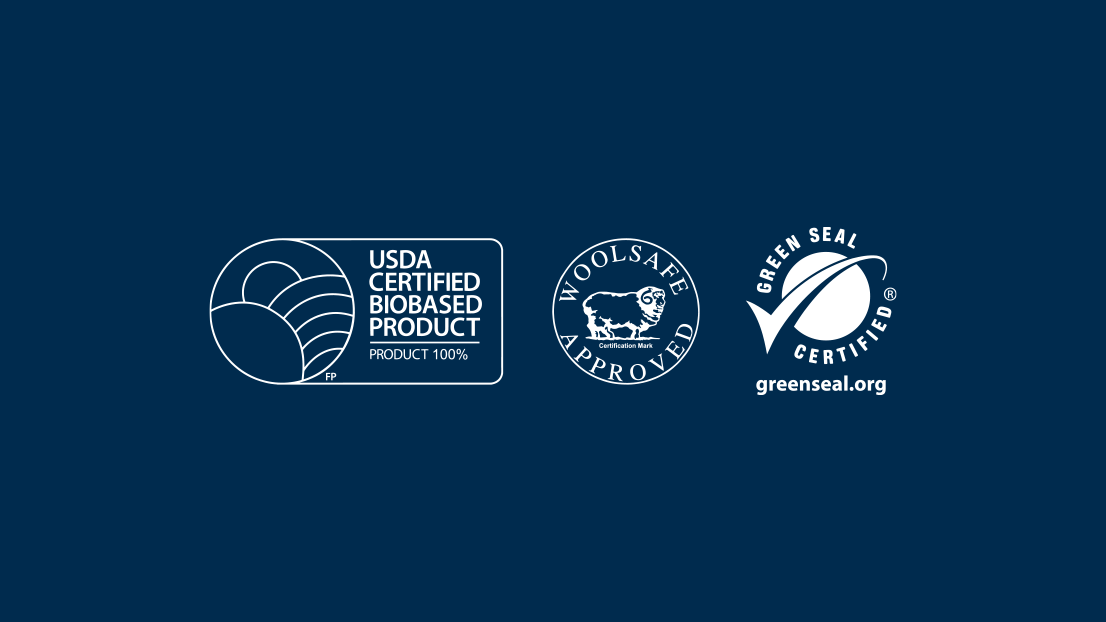
It is great that there are many “green” cleaning choices nowadays. But a product isn’t environmentally preferable if it doesn’t WORK. It’s relatively easy to formulate a product that doesn’t cause harm in various ways, and likewise it’s relatively easy to formulate something that works but has unintended consequences or downstream effects. It takes skill and experience and listening to surfaces and customers in order to formulate something that also does what it claims. HOST products have decades and decades of such skill and experience behind them, with the proof to back them up. Proof like third-party testing and validation, and life-long happy users.
WoolSafe®, for instance, performs tests to ensure a product is effective. And “effective” means more than just cleaning: it means that it also has low re-soiling characteristics, is low in alkalinity, has no bleaching agents, has no optical brighteners, is nonflammable, is nonhazardous, is environmentally responsible, and has clear and concise use directions.
Green Seal® is another third-party validator who verifies that a product is environmentally preferable. Their broad standards have prerequisites like excluding known and questionably harmful substances that may affect health, the air, water, and soil. Green Seal standards include other potential environmental issues as well, like packaging limitations and product usage.
While a number of products have these certifications, HOST exceeds:
BIOBASED
US Department of Agriculture’s BioPreferred® Program tests and certifies biobased products. Biobased products are composed in whole or in part of biological products or renewable domestic agricultural resources, and are generally safer for the environment than their petroleum counterparts. Biobased products are usually biodegradable or recyclable. HOST is the first dry carpet cleaning product to receive BioPreferred certification, receiving it’s certification as 100% biobased over 20 years ago. It requires no special disposal (unlike cleaning wastewater which must go through treatment), and may even in some circumstances be composted.
LIFE CYCLE ANALYSIS
A close look at HOST by the National Institute of Standards and Technology’s (NIST) proved that HOST’s environmental footprint is the smallest of all the carpet cleaning products studied. We intend to keep it that way.
EPP
HOST exceeds the Environmental Protection Agency (EPA) recommendations for Environmentally Preferable Purchasing (EPP). “Environmentally preferable’’ means “products or services that have a lesser or reduced effect on human health and the environment when compared with competing products or services that serve the same purpose.” (Executive Order 13101)
INDOOR AIR QUALITY / HEALTH
According to the EPA, “moisture control is the key to mold control.” The HOST system uses less than one teaspoon of liquid per square foot, so unlike wet cleaning methods, HOST does not leave carpets wet with dirty wastewater that can lead to mold growth if it isn’t dried quickly enough. In fact, HOST also removes mold from carpets. The HOST system also removes cat allergen, tiny proteins that can cause health problems with many sufferers.
DUST MITES & MOLD / INTEGRATED PEST MANAGEMENT
The HOST system of applying HOST Dry Extraction Cleaner to the carpet, brushing it through the carpet, and extracting the HOST cleaner removes dirt and reduces allergens. Research studies have shown that one cleaning with the HOST system using professional/commercial HOST machines reduces dust mite allergen by 89% and mold spores by 97%. Products or equipment that advertise they remove dust mites and mold from the environment are under the jurisdiction of the EPA and must be made in an EPA registered facility. HOST machines are manufactured in an EPA registered facility, EPA Establishment Number 074202-WI-001.
WATER
Water extractors use large amount of water to clean. Further, they generate large amounts of wastewater which burdens sewers and water treatment facilities. And the wastewater left in a carpet slowly evaporates, humidifying buildings and forcing air conditioning and dehumidifying systems to work harder and longer—a huge unseen cost. Using HOST saves water. In fact, the HOST system deep cleans carpet with 97% less water than typical high-flow water extractors. Compared to a typical high-flow water extraction cleaning of 50,000 square feet of carpet, the HOST system saves 205,716 gallons of fresh water, reduces wastewater by 174,859 gallons and reduces water affecting indoor humidity by 30,857 gallons, relieving the workload on HVAC systems and reducing mold growth potential.
ENERGY
Heating water in most water extraction systems is a sizable energy cost, no matter how one is heating it. The HOST system avoids this cost entirely. Even compared to cleaning systems using water but without heat, HOST still has no wastewater dumping costs, wastewater treatment energy costs, and no big dehumidifying energy burden. Such as no water to heat, no water to pump, no need for blowers/fans, no need for air conditioners & dehumidifiers to remove moisture from the carpet & air and no wastewater treatment costs
LEED
US Green Building Council’s LEED (Leadership in Energy & Environmental Design) Green Building Rating System “is a voluntary, consensus-based, national standard for developing high-performance, sustainable buildings. Using the HOST system may contribute to earning LEED points in numerous standard categories, such as Energy and Atmosphere, Materials and Resources, Water Efficiency, Indoor Environmental Quality, and Integrated Pest Management.

